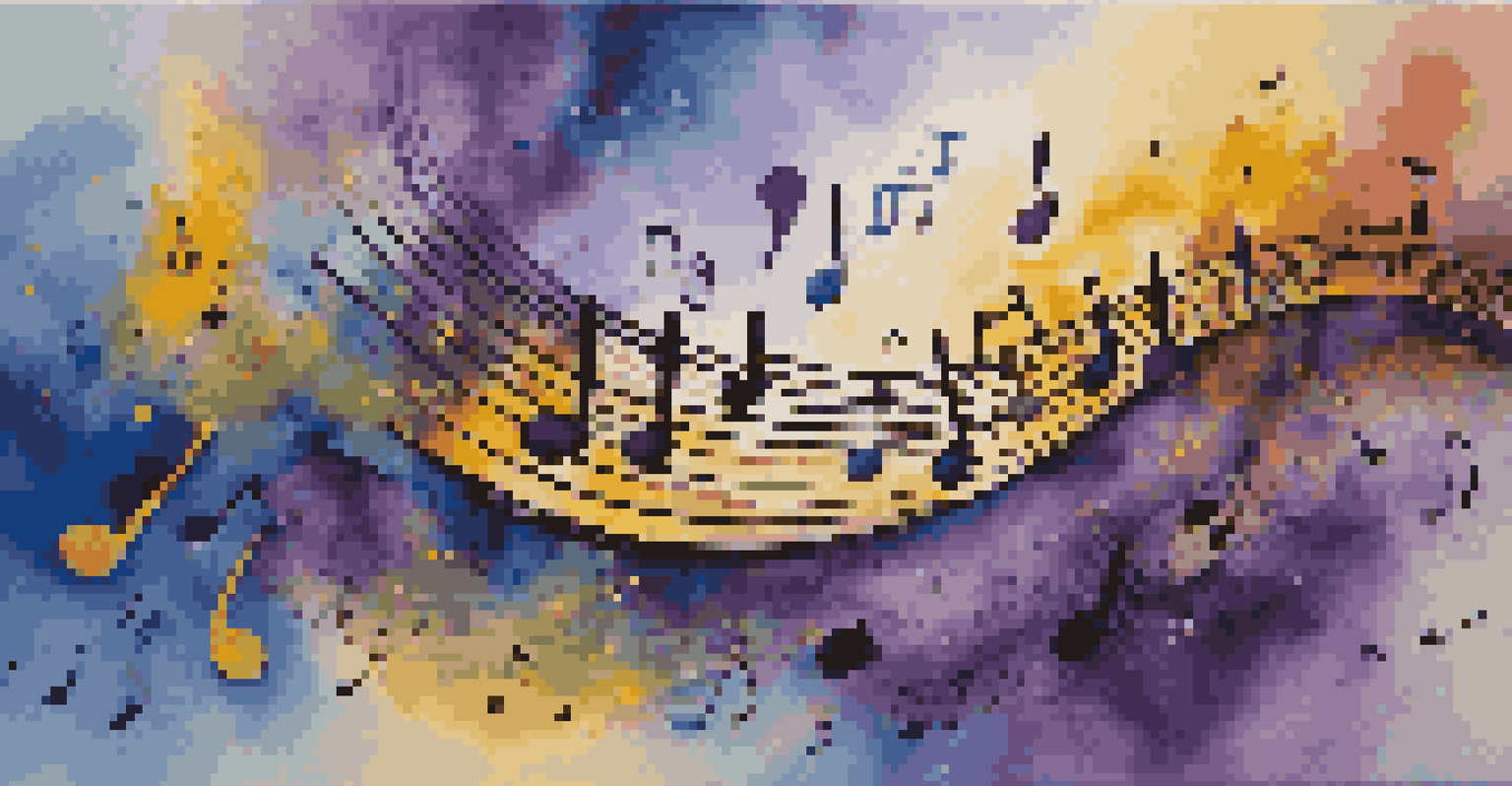Using Metaphors and Imagery in Music Critique

Understanding the Power of Metaphors in Music
Metaphors are a powerful tool in music critique, allowing listeners to connect emotionally with the music. They create vivid images that help articulate feelings and interpretations that might be difficult to express directly. For example, saying a song 'takes you on a journey' suggests a narrative experience, inviting listeners to visualize their own path through the music.
Music can change the world because it can change people.
Using metaphors can also bridge the gap between different musical genres and styles. When a critic describes a jazz solo as 'like a dance of lightning,' it evokes a dynamic visual that can resonate with both jazz enthusiasts and casual listeners. This approach not only enhances understanding but also enriches the listening experience.
Ultimately, metaphors serve as a lens through which we can explore the deeper meanings behind the notes and lyrics. They encourage listeners to engage their imagination, fostering a more personal connection to the music. In this way, metaphors are not just embellishments; they are essential elements of music critique.
Imagery: Painting Pictures with Words
Imagery in music critique refers to the use of descriptive language that evokes sensory experiences. Critics often paint a picture with words to help the audience visualize the essence of a piece. For instance, describing a song's sound as 'a warm sunset' can evoke feelings of comfort and nostalgia, creating a relatable emotional context.

By employing vivid imagery, critics can transport readers into the world of the music, allowing them to experience it more fully. Imagery can also highlight contrasts and emotions, such as describing a haunting melody as 'echoing through an empty hall,' which conjures feelings of loneliness and reflection. This helps listeners understand the emotional landscape of the music.
Metaphors Enhance Music Connection
Metaphors create vivid imagery that allows listeners to emotionally connect with music and explore its deeper meanings.
Moreover, effective imagery captures the nuances and subtleties of a performance, making the critique more engaging. When a critic describes a vocalist's sound as 'silky smooth,' it not only conveys the quality of the voice but also invites the listener to imagine that texture. This connection between language and sound is what makes imagery a vital component of music critique.
The Role of Emotion in Music Critique
Emotion plays a crucial role in how we perceive and critique music. When critics use metaphors and imagery, they tap into the emotional responses that music naturally evokes. For instance, describing a song as 'a heart-wrenching ballad' immediately sets the emotional tone, allowing readers to anticipate the feelings they might experience.
The beauty of music is that it connects people. It brings together those who are far apart.
This emotional engagement helps to create a deeper understanding of the music's impact. By articulating feelings through metaphoric language, critics can connect with readers on a more personal level. When someone reads that a song 'whispers sweet nothings,' they can visualize intimate moments, enhancing their appreciation for the piece.
Ultimately, music critique is as much about the emotional journey as it is about technical analysis. By weaving emotion into their critiques, writers can create a narrative that resonates with readers, encouraging them to listen with fresh ears. This interplay between emotion and critique enriches the overall experience of music appreciation.
Creating Relatable Connections Through Analogies
Analogies, much like metaphors, help create relatable connections between unfamiliar concepts and familiar experiences. In music critique, using analogies can make complex musical ideas more accessible. For instance, comparing a composer’s style to 'the brush strokes of a painter' helps readers visualize the intricacies of their work.
Analogies can also serve to highlight the evolution of an artist’s sound over time. For example, stating that an artist’s latest album is 'like a fine wine, maturing with age' captures the essence of growth and refinement. Such comparisons not only clarify the critique but also invite readers to reflect on their own experiences with music.
Imagery Evokes Sensory Experiences
Descriptive language in music critique paints pictures that help audiences visualize and feel the essence of a piece.
Moreover, relatable analogies can foster a sense of community among music lovers, as they highlight shared experiences. When a critic draws parallels between a song and a memorable life event, it resonates with readers who have felt similarly. This connection enhances the overall impact of the critique, making it more engaging and memorable.
The Importance of Context in Music Imagery
Context is key when interpreting metaphors and imagery in music critique. A metaphor that works beautifully in one genre might fall flat in another. For example, likening a punk rock anthem to 'a battle cry' resonates deeply within its cultural context but might not translate to classical music, where such imagery would feel out of place.
Critics must consider the historical, cultural, and emotional context surrounding a piece of music to ensure their imagery is effective. This awareness allows for a richer critique that respects the artist's intent while connecting with the audience. A well-contextualized metaphor can elevate a critique from ordinary to extraordinary, making it a more powerful tool for engagement.
Furthermore, context can help readers understand the layers of meaning within a song. When a critic mentions the socio-political backdrop of a piece, the imagery takes on additional significance, enriching the listener's experience. This depth is what makes music critique an art form in itself, merging analysis with vivid storytelling.
Combining Metaphors and Imagery for Impact
Combining metaphors and imagery can create a powerful and immersive critique. When used together, they enhance each other, painting a rich picture that captivates readers. For instance, describing a song as 'a storm of emotions that crashes and recedes' uses both metaphor and imagery to evoke a dynamic emotional experience.
This combination allows critics to convey complex feelings and thoughts in a relatable way. It invites readers to not only understand but to feel the music, making the critique more engaging. By interweaving these elements, critics can craft narratives that resonate on multiple levels, from the lyrical to the emotional.
Context Shapes Music Critique
Understanding the historical and cultural context is essential for effective metaphors and imagery in music critique.
In essence, the synergy between metaphors and imagery amplifies the impact of music critique. Each element enriches the other, deepening the audience's understanding and connection to the music. This holistic approach is what sets great critiques apart, transforming them into memorable explorations of sound and emotion.
The Future of Metaphors and Imagery in Music Critique
As music continues to evolve, so too will the language of music critique. The rise of digital platforms has opened new avenues for creativity, allowing critics to explore metaphors and imagery in innovative ways. For example, incorporating multimedia elements, like videos or visual art, can enhance the metaphoric language used in written critiques.
Moreover, as genres continue to blend and evolve, the metaphors we use may also become more diverse and inclusive. Critics will need to adapt their language to resonate with a broader audience, reflecting the rich tapestry of contemporary music. This evolution will not only keep critiques fresh but also ensure they remain relevant in an ever-changing landscape.

Ultimately, the future of music critique lies in its ability to connect with listeners on a deeper level. By embracing the art of metaphors and imagery, critics can continue to foster appreciation and understanding of music. As we move forward, these tools will remain vital in capturing the essence of sound and emotion in our shared musical journey.